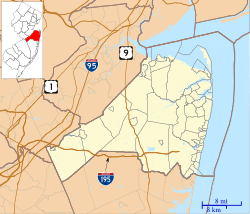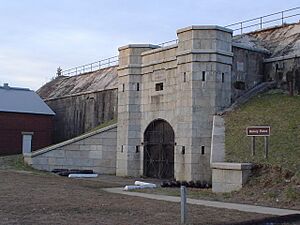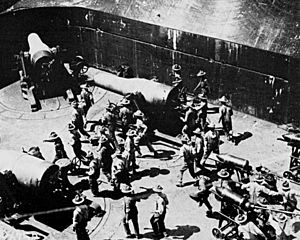Fort Hancock, New Jersey facts for kids
|
Fort Hancock and the Sandy Hook Proving Ground Historic District
|
|

Fort Hancock Memorial Park
|
|
| Location | Sandy Hook, New Jersey |
|---|---|
| Built |
|
| Architect | Capt. Robert E. Lee, United States Army Corps of Engineers |
| Architectural style | Third System (1857 fort), Endicott Program (Fort Hancock) |
| NRHP reference No. | 80002505 |
Quick facts for kids Significant dates |
|
| Added to NRHP | April 24, 1980 |
| Designated NHLD | December 17, 1982 |
Fort Hancock is a former United States Army fort located on Sandy Hook in New Jersey. This important coastal artillery base protected the Atlantic coast and the entrance to New York Harbor. Its first big guns were ready for action in 1896.
The fort was active from then until 1950. It was a key part of the Harbor Defenses of New York. From 1874 to 1919, the nearby Sandy Hook Proving Ground was also used. This was a place where new weapons were tested. Today, Fort Hancock is part of Fort Hancock Memorial Park.
Before Fort Hancock, there was an older fort called the Fort at Sandy Hook. It was built between 1857 and 1867. The famous Sandy Hook Light, built in 1764, is also located here. It is the oldest working lighthouse in the United States.
History of Fort Hancock
Building the First Fort at Sandy Hook
The Sandy Hook area was first fortified as part of the "third system" of US forts. These were strong forts built to defend the coast. Construction on the Fort at Sandy Hook started in 1857. It stopped in 1867, but the fort could still be used. This fort never got an official name. People sometimes called it Fort Lincoln or Fort Hudson.
The first design for the fort was made by Captain Robert E. Lee. He was part of the Army Corps of Engineers. The fort was shaped like a five-sided building with strong walls. It was designed to hold 173 cannons facing the sea. Another 39 guns protected the land side.
Like other forts from this time, it was mostly built from granite. After the American Civil War, it became clear that stone forts could be easily damaged by new, powerful rifles. So, funding for building them stopped in 1867. The fort was never fully finished. In 1885, most of its materials were used to build the new Sandy Hook Proving Ground and Fort Hancock. Only a small part of one wall with four cannon openings remains today.
Fort Hancock: A New Era of Defense
In 1874, the Sandy Hook Proving Ground was set up. This was a special area for testing weapons. It was mainly used for testing coast defense weapons. This proving ground was run by the Ordnance Department. It was separate from Fort Hancock.
In 1890, work began on the new gun batteries at Fort Hancock. The fort was named in 1895 after Major General Winfield Scott Hancock. These new batteries were part of a big plan called the Endicott Program. This program started in 1885 to build a new, strong system of forts to protect port cities. Fort Hancock was one of the first forts built. It helped test new ways to install weapons.
The first batteries built were Battery Potter and Battery Reynolds. They were designed with high walls all around. This was to protect them from attacks from the land. This feature was not common in later US forts.
Battery Potter: The Unique Gun Lift
Battery Potter was a special test battery. It used a steam-powered hydraulic system to lift its guns. Most guns in the Endicott Program were "disappearing guns." These guns stayed hidden behind a concrete wall. They would only pop up to fire. But engineers weren't sure if the disappearing carriage could lift a very heavy 12-inch gun.
The "gun lift carriage" was the solution. It was like an elevator for the gun. A steam engine provided the power to lift the gun. One cool thing about this system was that the gun could shoot in any direction (360 degrees). Battery Potter got its first 12-inch gun in 1892. It was finished in 1894.
However, the gun lift system was very expensive to build and run. The steam engine had to be on all the time to keep the pressure up. Because of this, Battery Potter was the only gun lift battery ever completed. In 1903, it was named after Joseph H. Potter, a Civil War general. By 1907, other batteries were built, and Battery Potter's guns were removed.
Battery Reynolds: Mortar Pits
Battery Reynolds (part of which became Battery McCook in 1906) had sixteen 12-inch mortars. These were big guns that fired shells high into the air. They were arranged in a "Abbot Quad" pattern. This design put four mortars very close together in a square pit. The idea was to fire them all at once to hit an enemy ship.
The battery had four pits, each with four mortars. Concrete walls separated the pits. These walls also held ammunition and storage. The whole battery was surrounded by a high concrete wall for protection. This design was used in some early forts. But it was hard to reload all the mortars in each pit at the same time. Later, some mortars were moved to other locations. Newer battery designs had mortars in a line, making them easier to use.
Early Fort Hancock Guns
By 1909, Fort Hancock had many different types of guns. Here are some of the main ones:
| Name | Number of guns | Gun type | Carriage type | Years active |
|---|---|---|---|---|
| Dynamite | 2 | 15-inch (381 mm) dynamite gun | pedestal | 1896–1902 |
| Dynamite | 1 | 8-inch (203 mm) dynamite gun | pedestal | 1896–1902 |
| Potter | 2 | 12-inch (305 mm) gun M1888 | gun lift M1891 | 1898–1907 |
| Reynolds | 8 | 12-inch (305 mm) mortar M1886 | barbette M1891 | 1898–1918 |
| McCook | 8 | 12-inch (305 mm) mortar M1886 | barbette M1891 | 1898–1923 |
| Alexander | 2 | 12-inch (305 mm) gun M1888 | disappearing M1896 | 1899–1943 |
| Bloomfield | 2 | 12-inch (305 mm) gun M1888 | disappearing M1896 | 1899–1944 |
| Richardson | 2 | 12-inch (305 mm) gun M1895 | disappearing M1901 | 1904–1944 |
| Halleck | 3 | 10-inch (254 mm) gun M1888 | disappearing M1896 | 1898–1944 |
| Granger | 2 | 10-inch (254 mm) gun M1888 | disappearing M1896 | 1898–1942 |
| Arrowsmith | 3 | 8-inch (203 mm) gun M1888 | disappearing M1894 | 1909–1920 |
| Peck | 2 | 6-inch (152 mm) gun M1900 | pedestal M1900 | 1903–1946 |
| Gunnison | 2 | 6-inch (152 mm) gun M1903 | disappearing M1903 | 1905–1946 |
| Engle | 1 | 5-inch (127 mm) gun M1897 | balanced pillar M1896 | 1898–1917 |
| Unnamed | 1 | 4.72-inch (120 mm) Schneider gun | pedestal | 1898-1898 |
| Urmston | 4 | 3-inch (76 mm) gun M1898 | masking parapet M1898 | 1903–1920 |
| Urmston | 2 | 3-inch (76 mm) gun M1903 | pedestal M1903 | 1909–1946 |
| Morris | 4 | 3-inch (76 mm) gun M1903 | pedestal M1903 | 1908–1946 |
The fort also had ways to set up and control underwater minefields. Battery Dynamite used special "dynamite guns." These guns fired shells filled with a lot of explosives. But they were hard to aim, so they were removed by 1902.
Batteries Bloomfield, Richardson, Halleck, and Alexander formed the "Nine Gun Battery." This was one of the longest lines of guns in the Endicott system. The smaller 3-inch guns were often called "mine defense" guns. They were meant to protect the minefields from enemy ships trying to clear them.
Fort Hancock During World War I
When the United States entered World War I, some changes happened at forts across the country. The goal was to send heavy artillery to the Western Front in Europe. Fort Hancock was not affected as much as other forts. This was probably because it was so important for defending New York City.
One 10-inch gun from Battery Halleck was taken away to be used as a railway gun. Several other guns were listed for removal but stayed at the fort. Battery Engle's 5-inch gun was removed to be used as a field gun and never came back. Also, four mortars from Battery Reynolds-McCook were moved in 1917. They were set up at the Highlands Military Reservation to the south of Sandy Hook.
In 1917, construction began on two new 12-inch gun batteries at Fort Hancock. These batteries, named Battery Kingman and Battery Mills, were finished in 1921. They had long-range guns.
Between the World Wars
After World War I, more changes happened for coastal artillery. The proving ground functions were moved to Aberdeen Proving Ground in Maryland. The 8-inch guns of Battery Arrowsmith were removed. All the mortars from Battery Reynolds-McCook were also taken away. The 3-inch guns of Battery Urmston were removed in 1920.
The new long-range 12-inch batteries at Fort Hancock, along with very large 16-inch guns at Fort Tilden, became the main defenses for New York. The older guns stayed in place until World War II. The new 12-inch batteries were later covered with concrete to protect them from air attacks in 1942–43. Fort Hancock was mostly quiet from 1919 until the 1930s.
In 1931, some railway artillery units were stationed at the fort. They used the fort as a practice range for their railway guns.
Fort Hancock in World War II
In 1940–41, Fort Hancock became a busy training center. Many soldiers came here for training. First, there was a tent city, and then many temporary buildings were built for the trainees.
With the powerful 12-inch and 16-inch guns already in place, many of Fort Hancock's older guns were taken apart for scrap metal in 1942–43. In 1943, a harbor control post was built on the old Battery Potter. Battery Gunnison was rebuilt to hold 6-inch guns from Battery Peck. This battery became known as Battery New Peck.
Two Anti-Motor Torpedo Boat (AMTB) batteries were also set up. Each had four 90mm guns. These were used to defend against fast enemy boats.
The Cold War Era
In 1946, it was decided that big gun defenses were no longer needed. Fort Hancock's guns were scrapped. The fort was officially closed in 1950. But a year later, it was reopened. It became a base for 90mm and 120mm anti-aircraft guns. These were the first defenses built in the US during the Cold War.
The fort was closed again in 1953. But it reopened in 1956 as a Nike missile base (called site NY-56). These Nike missiles were used to shoot down enemy aircraft. This lasted until 1974, when the Nike missile system was shut down in the US.
After the Cold War
Hurricane Sandy in 2012 damaged some buildings at Fort Hancock. In 2018, the National Park Service decided to tear down these damaged buildings.
Fort Hancock Today
Fort Hancock stopped being an active U.S. Army base in 1974. Now, it is part of the National Parks of New York Harbor. It is managed by the National Park System. There is a museum at the Sandy Hook Unit of Gateway National Recreation Area. In 2013, Nubian goats were brought to the fort. They helped clear away poison ivy that had been growing there for many years.
A special committee was formed in 2012. Its job is to advise the National Park Service on how to use the fort's empty buildings. People can propose ideas to lease and fix up the buildings. As of 2018, some buildings are being leased or planned for use. The National Park Service is also working to repair structures damaged by Hurricane Sandy.
At the fort, you can see a 20-inch (508 mm) Rodman gun. This was the biggest gun made during the Civil War era. There is also a 10-inch (254 mm) Rodman gun and several Nike missiles. Two rare 6-inch (152 mm) M1900 guns are displayed at Battery New Peck, also known as Battery Gunnison.
Battery Gunnison was the only gun battery at Fort Hancock that was not scrapped after World War II. It still has these two guns from 1903. Since 2003, a group called the Army Ground Forces Association has been restoring the battery. They are making it look like it did in 1943 during World War II. They also offer living history programs throughout the year.
Fort Hancock has one of the largest collections of preserved Endicott batteries. These include experimental batteries from the old proving ground. You can still see the dynamite gun battery. Many of the old buildings where soldiers lived also remain. However, only a small piece of the wall from the very first fort, with four gun openings, is left.
Nike Site NY-56 is one of the few Nike missile bases left in the country where both the launch and radar areas are still mostly complete. The launch area was damaged by Hurricane Sandy. But the radar site, located at Horseshoe Cove, is being restored by US Army Air Defense Artillery veterans. Some of these veterans were stationed at Fort Hancock in the 1960s and 70s.
Images for kids
-
A 6-inch gun on an M1900 pedestal mount, seen at Emplacement Number 1 of Battery Fremont Peck. These guns were moved to Battery John Gunnison in 1943, where the Battery became "Battery New Peck." They are still there today, and Battery Gunnison / New Peck is being fully restored to how it looked in 1943 during World War II.













